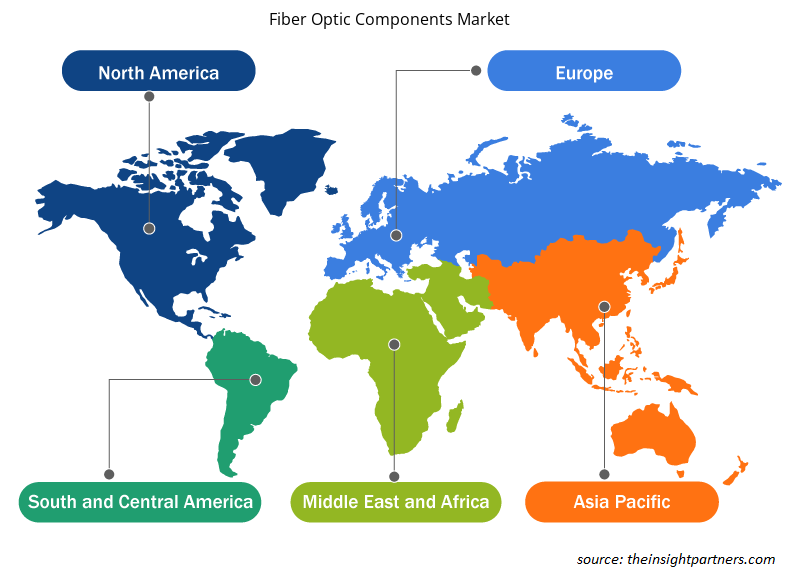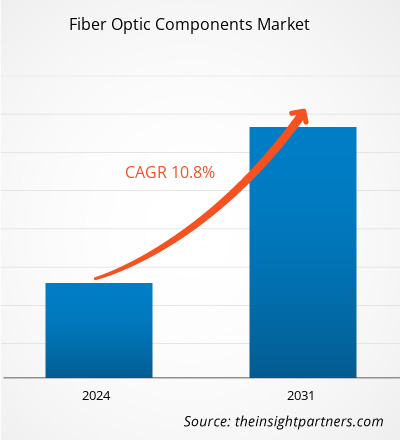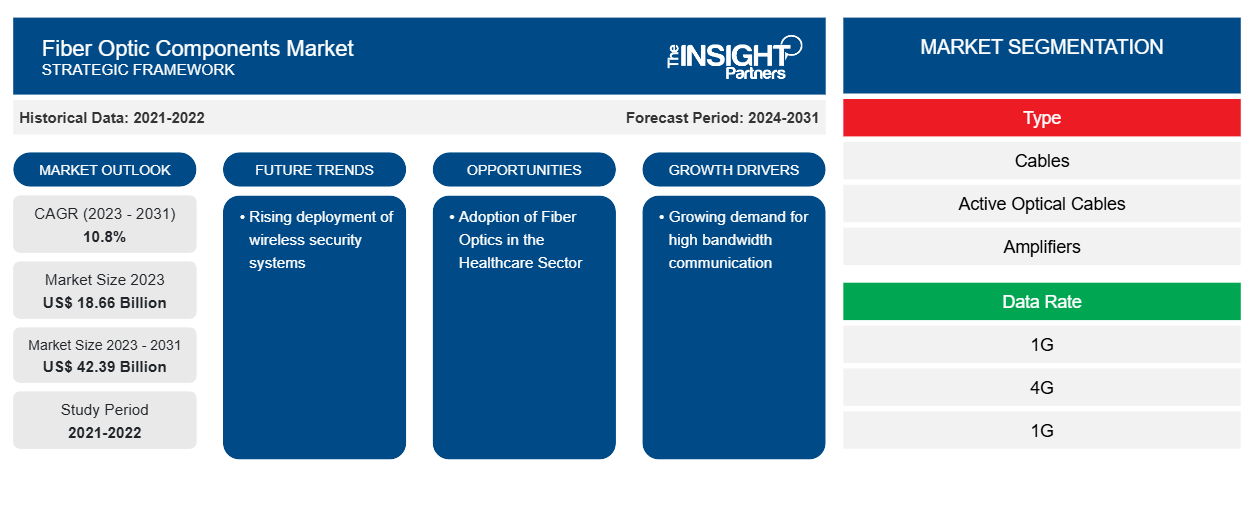Der globale Markt für Glasfaserkomponenten soll von 18,66 Milliarden US-Dollar im Jahr 2023 auf 42,39 Milliarden US-Dollar im Jahr 2031 wachsen; von 2023 bis 2031 wird eine durchschnittliche jährliche Wachstumsrate von 10,8 % erwartet. Der zunehmende Einsatz drahtloser Sicherheitssysteme dürfte weiterhin ein wichtiger Trend auf dem Markt für Glasfaserkomponenten bleiben.CAGR of 10.8% from 2023 to 2031. The rising deployment of wireless security systems is likely to remain key fiber optic components market trends.
Marktanalyse für Glasfaserkomponenten
Das Wachstum dieses Marktes wird durch eine Reihe kommerzieller Gründe vorangetrieben, darunter der verstärkte Einsatz von Rechenzentren, die zunehmende Verbreitung des Internets und des Datenverkehrs, der steigende Bedarf an Bandbreite und Zuverlässigkeit sowie Verbesserungen im Ökosystem der Glasfaserkomponenten.
Marktübersicht für Glasfaserkomponenten
Eine typische Glasfaser besteht aus drei Hauptkomponenten: dem Kern, der das Licht transportiert; dem Mantel, der den Kern mit einem niedrigeren Brechungsindex umgibt und das Licht einschließt; und der Beschichtung, die die empfindliche Faser im Inneren schützt. Der Kern, der das Licht transportiert, ist die kleinste Komponente der Glasfaser. Glasfaserkerne bestehen normalerweise aus Glas, einige sind aus Kunststoff. Der Mantel umgibt den Kern und sorgt für einen niedrigeren Brechungsindex, wodurch die Glasfaser funktioniert. Bei Verwendung eines Glasmantels bestehen Mantel und Kern aus demselben Material auf Siliziumdioxidbasis in einem dauerhaft verschmolzenen Zustand. Die Beschichtung ist die Schutzhülle der Glasfaser. Die Schicht absorbiert Stöße, Kerben, Kratzer und sogar Feuchtigkeit, die den Mantel beschädigen können. Ohne die Beschichtung ist die Glasfaser extrem spröde.
Passen Sie diesen Bericht Ihren Anforderungen an
Sie erhalten kostenlos individuelle Anpassungen an jedem Bericht, einschließlich Teilen dieses Berichts oder einer Analyse auf Länderebene, eines Excel-Datenpakets sowie tolle Angebote und Rabatte für Start-ups und Universitäten.
-
Holen Sie sich die wichtigsten Markttrends aus diesem Bericht.Dieses KOSTENLOSE Beispiel umfasst eine Datenanalyse von Markttrends bis hin zu Schätzungen und Prognosen.
Treiber und Chancen auf dem Markt für Glasfaserkomponenten
Steigende Nachfrage nach Breitbandkommunikation begünstigt Markt
Der Bedarf an kabelgebundenem Hochgeschwindigkeitsinternet und Breitbandnetzinfrastrukturen wächst, was wiederum die Nachfrage nach Glasfaserkabeln in die Höhe treibt. Mehrere Faktoren tragen zu diesem Bedarf bei, darunter die Notwendigkeit schneller Internetverbindungen für spezielle Programme wie Spiele, Medien und Videostreaming. Glasfaserleitungen haben eine größere Bandbreitenkapazität und können Daten mit höherer Geschwindigkeit übertragen als Kupferdrähte. Glasfaserkabel haben einen geringeren Signalverlust und sind weniger anfällig für elektromagnetische Störungen, was zu einer zuverlässigeren und robusteren Kommunikation führt.
Einführung von Glasfaser im Gesundheitswesen
Das Gesundheitswesen entwickelt und implementiert ständig neue Technologien, um die Patientenversorgung und die Kommunikation zwischen dem Gesundheitspersonal zu verbessern. Glasfasernetze sind für diesen Wandel von entscheidender Bedeutung, da sie die zuverlässigste und sicherste Konnektivität bieten. Dieser ausführliche Leitfaden befasst sich mit den Vorteilen von Glasfasernetzen im Gesundheitswesen , den Spitzentechnologien, die sie ermöglichen, und der digitalen Revolution der Branche. Das Gesundheitswesen ist ein großer Anwender von Glasfaser-Internet und -Netzwerken. Gesundheitsunternehmen sind auf schnelle, sichere Internetverbindungen angewiesen, um eine schnelle und sichere Übermittlung von Patientendaten zu gewährleisten. Glasfasernetze sind außerdem skalierbarer als herkömmliche Internetverbindungen.scalable than traditional internet connections.
Segmentierungsanalyse des Marktberichts für Glasfaserkomponenten
Wichtige Segmente, die zur Ableitung der Marktanalyse für Glasfaserkomponenten beigetragen haben: Typ, Datenrate und Anwendung.
- Nach Typ ist der Markt in Kabel, aktive optische Kabel (AOC), Verstärker, Splitter, Steckverbinder, Zirkulatoren, Transceiver und andere unterteilt. Das Kabelsegment hatte im Jahr 2023 einen größeren Marktanteil.AOC), amplifiers, splitters, connectors, circulators, transceivers, and others. The cables segment held a larger market share in 2023.
- Basierend auf der Datenrate ist der Markt in 10G, 40G, 100G und über 100G unterteilt. Das 100G-Segment hatte im Jahr 2023 einen größeren Marktanteil.
- Basierend auf der Anwendung ist der Markt in Kommunikation, verteilte Sensorik, analytische und medizinische Geräte sowie Beleuchtung unterteilt. Das Kommunikationssegment hatte im Jahr 2023 einen größeren Marktanteil.
Marktanteilsanalyse für Glasfaserkomponenten nach Geografie
Der geografische Umfang des Marktberichts für Glasfaserkomponenten ist hauptsächlich in fünf Regionen unterteilt: Nordamerika, Asien-Pazifik, Europa, Naher Osten und Afrika sowie Südamerika/Süd- und Mittelamerika. Nordamerika dominierte den Markt für Glasfaserkomponenten im Jahr 2023. Technologische Fortschritte wie der Einsatz von drahtloser Technologie, Cloud-Computing-Plattformen und IoT-basierten Sicherheitssystemen treiben das Wachstum des Marktes für Glasfaserkomponenten voran. Diese Fortschritte verbessern die Effizienz, den Komfort und die Effektivität drahtloser Kommunikationssysteme.IoT-based security systems, are propelling the growth of the fiber optic components market. These advancements improve the efficiency, convenience, and effectiveness of wireless communication systems.
Regionale Einblicke in den Markt für Glasfaserkomponenten
Die regionalen Trends und Faktoren, die den Markt für Glasfaserkomponenten im Prognosezeitraum beeinflussen, wurden von den Analysten von Insight Partners ausführlich erläutert. In diesem Abschnitt werden auch die Marktsegmente und die Geografie für Glasfaserkomponenten in Nordamerika, Europa, im asiatisch-pazifischen Raum, im Nahen Osten und Afrika sowie in Süd- und Mittelamerika erörtert.

- Erhalten Sie regionale Daten zum Markt für Glasfaserkomponenten
Umfang des Marktberichts zu Glasfaserkomponenten
| Berichtsattribut | Details |
|---|---|
| Marktgröße im Jahr 2023 | 18,66 Milliarden US-Dollar |
| Marktgröße bis 2031 | 42,39 Milliarden US-Dollar |
| Globale CAGR (2023 - 2031) | 10,8 % |
| Historische Daten | 2021-2022 |
| Prognosezeitraum | 2024–2031 |
| Abgedeckte Segmente |
Nach Typ
|
| Abgedeckte Regionen und Länder |
Nordamerika
|
| Marktführer und wichtige Unternehmensprofile |
|
Marktteilnehmerdichte: Der Einfluss auf die Geschäftsdynamik
Der Markt für Glasfaserkomponenten wächst rasant, angetrieben durch die steigende Nachfrage der Endnutzer aufgrund von Faktoren wie sich entwickelnden Verbraucherpräferenzen, technologischen Fortschritten und einem größeren Bewusstsein für die Vorteile des Produkts. Mit steigender Nachfrage erweitern Unternehmen ihr Angebot, entwickeln Innovationen, um die Bedürfnisse der Verbraucher zu erfüllen, und nutzen neue Trends, was das Marktwachstum weiter ankurbelt.
Die Marktteilnehmerdichte bezieht sich auf die Verteilung der Firmen oder Unternehmen, die in einem bestimmten Markt oder einer bestimmten Branche tätig sind. Sie gibt an, wie viele Wettbewerber (Marktteilnehmer) in einem bestimmten Marktraum im Verhältnis zu seiner Größe oder seinem gesamten Marktwert präsent sind.
Die wichtigsten auf dem Markt für Glasfaserkomponenten tätigen Unternehmen sind:
- Accelink Technology Co. Ltd.
- Broadcom, Inc.
- EMCORE Corporation
- Fujitsu Limited
- Furukawa Electric Co. Ltd.
- Kohärent
Haftungsausschluss : Die oben aufgeführten Unternehmen sind nicht in einer bestimmten Reihenfolge aufgeführt.

- Überblick über die wichtigsten Akteure auf dem Markt für Glasfaserkomponenten
Neuigkeiten und aktuelle Entwicklungen zum Markt für Glasfaserkomponenten
Der Markt für Glasfaserkomponenten wird durch die Erhebung qualitativer und quantitativer Daten nach Primär- und Sekundärforschung bewertet, die wichtige Unternehmensveröffentlichungen, Verbandsdaten und Datenbanken umfasst. Im Folgenden finden Sie eine Liste der Entwicklungen auf dem Markt:
- Im September 2023 entwickelte Fujitsu eine optische Übertragungstechnologie, die Daten mit einer Geschwindigkeit von bis zu 1,2 Tbit/s pro optischer Welle liefern kann. Das entspricht der Übertragung der Daten von sechs Blu-ray-Discs (jede mit einer Kapazität von 25 GB) in nur einer Sekunde.
(Quelle: Fujitsu, Pressemitteilung, 2023)
Marktbericht zu Glasfaserkomponenten – Umfang und Ergebnisse
Der Bericht „Marktgröße und Prognose für Glasfaserkomponenten (2021–2031)“ bietet eine detaillierte Analyse des Marktes, die die folgenden Bereiche abdeckt:
- Marktgröße und Prognose auf globaler, regionaler und Länderebene für alle wichtigen Marktsegmente, die im Rahmen des Projekts abgedeckt sind
- Marktdynamik wie Treiber, Beschränkungen und wichtige Chancen
- Wichtige Zukunftstrends
- Detaillierte PEST/Porters Five Forces- und SWOT-Analyse
- Globale und regionale Marktanalyse mit wichtigen Markttrends, wichtigen Akteuren, Vorschriften und aktuellen Marktentwicklungen
- Branchenlandschaft und Wettbewerbsanalyse, einschließlich Marktkonzentration, Heatmap-Analyse, prominenten Akteuren und aktuellen Entwicklungen
- Detaillierte Firmenprofile
- Historische Analyse (2 Jahre), Basisjahr, Prognose (7 Jahre) mit CAGR
- PEST- und SWOT-Analyse
- Marktgröße Wert/Volumen – Global, Regional, Land
- Branchen- und Wettbewerbslandschaft
- Excel-Datensatz
Aktuelle Berichte
Verwandte Berichte
Erfahrungsberichte
Grund zum Kauf
- Fundierte Entscheidungsfindung
- Marktdynamik verstehen
- Wettbewerbsanalyse
- Kundeneinblicke
- Marktprognosen
- Risikominimierung
- Strategische Planung
- Investitionsbegründung
- Identifizierung neuer Märkte
- Verbesserung von Marketingstrategien
- Steigerung der Betriebseffizienz
- Anpassung an regulatorische Trends























 Kostenlose Probe anfordern für - Markt für Glasfaserkomponenten
Kostenlose Probe anfordern für - Markt für Glasfaserkomponenten